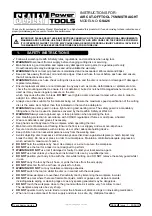
SAFETY PRECAUTIONS
WARNING
READ AND UNDERSTAND THESE SAFETY PRECAUTIONS BEFORE OPERATING MACHINE.
1.
Fuel.
This machine uses GASOLINE as the fuel and all precautions commonly applying
to this volatile fuel should be observed. Be careful not to spill gasoline over the machine, but if this
occurs, wipe it off and allow evaporation time before starting the machine.
GASOLINE ON THE
MACHINE OR SPILLED IN THE IMMEDIATE AREA IS HAZARDOUS. DO NOT ATTEMPT TO
PUT THE FUEL IN A HOT MACHINE.
2.
Fogging Formulations: (Model 2620) All thermal fogging formulations are
combustible,
that is, they all can be caused to burn. This is true, even of high flash point or “no”
flash point formulations. A combustible liquid vapor can be ignited because it readily forms a
uniform mixture with the air which contains the oxygen needed for combustion. However, fine
particles of combustible liquids or solids suspended in the air very closely spaced are capable of
propagating flame from one to another once ignition starts. A good analogy is the grain mill
explosion. Although the fine particle dust in a grain mill has “no” flash point, the phenomena of the
grain mill explosion is an all too common occurrence. While a high flashpoint or a “no” flashpoint
liquid formulation will ignite far less readily than a low flashpoint liquid, and for this reason is strongly
advocated, the high or “no” flashpoint formulation can ignite if the proper conditions exist. These
conditions are basically two: 1) a sufficient volume of liquid in the form of fine particles suspended in
the air; and 2) a sufficiently high energy source of ignition.
It is important to always employ a dry fog setting in a closed area to avoid depositing oil
particles on combustible surfaces, thus creating a fire hazard. If a combustible atmosphere is
established or a combustible deposit is laid down, a source of ignition may cause a fire. Even in
open areas, care should be taken to avoid unnecessary accumulations of oil particles on objects
within the fogging area. To avoid danger of fire or explosion in a closed space, the enclosed
volume, fogging time and required formulation volume must be carefully calculated.
(Model 2630).
This machine is intended for dispensing water based formulations only. Use
of formulations having a flammable base such as diesel oil, kerosene, fuel oil, gasoline, benzene, or
alcohol, may create hazardous conditions leading to a fire or explosion.
3.
Fog Concentration.
It has been fully established that an acceptable level of liquid in the
atmosphere is one gallon (3.8 liters) for each 50,000 cubic feet (1400 cubic meters). There is a
margin of safety of at least 5 to 1 in this figure. But, long before this concentration is reached, with
the fine white particle fog that this machine generates, visibility within the fog is reduced to less than
15 inches (38 CM). Thus, an operator fogging within a closed area will not be able to see his way
long before combustible atmosphere can be approached. However, if the operator is outside of the
closed area, it is quite possible to over-fog, particularly if the area is small, i.e., crawl spaces under
buildings or between ceiling and roof.
4.
Fog Ignition.
The greatest hazard of fog ignition is from an external source. This can be
gas or oil pilot lights or sparks from electrical controls such as switches, relays, etc. Therefore, it is
strongly recommended that all such sources be eliminated by extinguishing all pilot lights and
turning off all electrical power before fogging.
The design of the machine is such that it is quite difficult to ignite the fog from an external
source since the ignition must be positioned just at the proper distance from the discharge end to
cause fog ignition and this distance is on the order of only 8-6 inches (7.6-5.2 CM). If an external
source ignites the fog being discharged, it will produce a torching effect. Should this occur, quickly
rotate the 30way selector valve to the purge position to stop the fog discharge. Never artificially
wedge or block open the formulation automatic shut-off valve on the model 2620 Blackhawk.
6
Содержание BLACKHAWK 2620
Страница 1: ...MODEL 2620 2630 INSTRUCTION MANUAL FOR OPERATION SERVICE AND MAINTENANCE ...
Страница 24: ...24 ...
Страница 44: ... 12 86629 ASOV Assembly 12 ...
Страница 48: ...Figure 43 43 ...
Страница 52: ...REPLACEMENT PARTS LIST FIGURE 25 REF CURTIS NO PART NO DESCRIPTION 1 85574 Strap carry 2 86226 Pad strap 52 ...







































